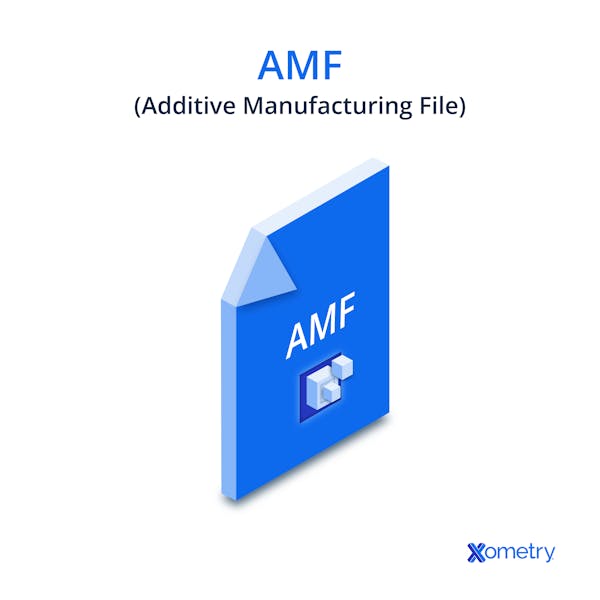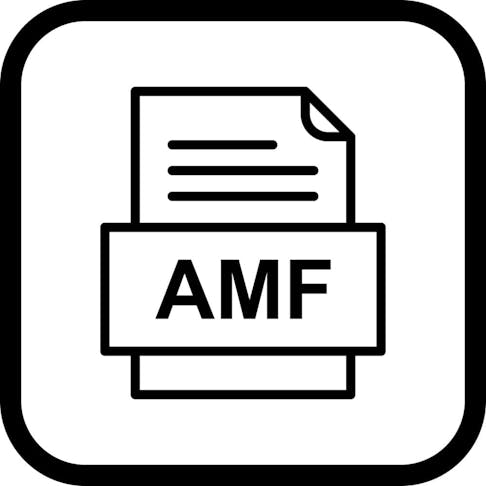The AMF (Additive Manufacturing File) file format is used to store data about 3D objects in CAD software. It was created specifically for the 3D printing industry and was recently developed by the American Society for Testing Materials (ASTM).
A single AMF file can contain information about one or more objects defined as triangular meshes. The shape, color, and material of these items can also be stored within the file. This allows the AMF file format to provide more detail about a modeled object's characteristics than its STL file format counterpart. AMF files can be created, imported, and edited with software like Meshmixer. These files are ideal for multicolored and multi-material 3D prints.
This article will discuss what AMF files are, who developed them, and how to create, open, and convert them.
What is an AMF File?
An additive manufacturing file, or AMF file, is a file format that CAD (Computer-aided Design) software uses to describe items for 3D printing. It contains one or more objects, each of which includes data that make up the object's shape, color, and material(s). AMF files also contain metadata that identifies the author, name, and copyright, as well as the constellation (arrangement in space) of numerous objects. An AMF file is an XML-based format created to be quicker, less prone to errors, and capable of storing data on color, material, and texture.

Who Created the AMF File Format?
The Additive Manufacturing File, known as AMF, was created by the American Society for Testing and Materials (ASTM) and was first launched in 2011. It was developed as an alternative to STL and OBJ formats, which were becoming an impediment to more advanced 3D printing. In the initial stages, both Autodesk® and SolidWorks® were involved in the development of the AMF file format.
In 2013, the AMF format was recognized as an official ISO standard (52915). An updated version, 1.2, was released in 2020. AMF is a significant improvement over STL and OBJ. In addition to addressing shortcomings like missing materials and other metadata, it also encodes 3D shapes in a more sophisticated manner. A number of model problems associated with STL in particular are almost entirely eliminated by the AMF file format. The AMF files use curved triangles that must adhere to stringent laws of topology and linkage.
How to Convert an AMF File
The process of converting AMF files for use in different software tools is usually very intuitive and typically involves a drag & drop/upload/import step, a conversion step, and a download or export step.
There are a number of software packages that can be used to convert AMF files. For example, Fusion 360® from Autodesk® can be used to convert AMF files to STP, STL, 3MF, FBX, OBJ, IPT, IAM, SKP, SMT, and USDZ file formats. Another popular program that can be used to convert AMF files is CNC Software Mastercam® for Windows.
How Do I Open an AMF File?
The steps in opening an AMF file vary depending on the tool or software used. In general, AMF files can be viewed using a variety of CAD programs, such as the free Autodesk Meshmixer® (multiplatform) program, CNC Software Mastercam® (Windows), and Autodesk Fusion 360® (multiplatform). It is recommended to check their specific processes for opening AMF files.
How Can I Make an AMF File?
To create an AMF file, simply export the file with a .amf extension. This can be done in the “Save As” or “Export” menu section in the software. Software programs such as Dassault Systèmes SolidWorks® and Autodesk® products can be used to export 3D object data to the AMF file format. AMF is also supported by most of the brand name slicers and 3D printers.
What is the Importance of an AMF File?
AMF files are important because they contain information about color, texture, and other non-geometrical attributes of objects — something that is not possible with STL files. As a result, AMF files are a little more complicated, but they are better suited for use in professional settings. Another important point is that the tessellated triangles in AMF files have the ability to curve and follow the model's geometry. Because of this ability, models are represented more accurately. AMF files can therefore contain an equivalent or greater volume of data while being smaller than STL files and significantly smaller than OBJ files.
What Are the Types of AMF Files?
Though the AMF file format discussed in this article is used for additive manufacturing, there are three other file types that use the .amf file extension. These should not be confused with one another, as they are used for very different purposes. The different AMF file types are:
- Additive Manufacturing File
- Asylum Music Format Audio File
- Advanced Module File
What Are the Best AMF File Converters?
The best AMF file converters are:
- SolidWorks®: When you export part or assembly documents from SolidWorks®, you can configure the export options as STL (.stl) or AMF (.amf) file formats. In other words, it supports STL to AMF conversion.
- Autodesk®: Various Autodesk® programs can be used to view and convert AMF files. However, the main Autodesk® application used for AMF files is MeshMixer. Applications like Fusion 360® and Autodesk FeatureCAM® 2023 (MDEU) can also be used.
SolidWorks® and Autodesk® both were involved in the initial stages of the development of the .amf file, and are considered to be two of the best AMF file converters.
What Are the Best Applications for AMF Files?
The best CAD applications for AMF files are:
- MeshMixer: Autodesk®'s MeshMixer is the main application used for .amf file formats. Because Meshmixer is primarily used to make or use AMF files, AMF files are frequently referred to as “Meshmixer CADs.”
- Cura: Cura, a 3D CAD program, can be used to slice and print 3D models. Using Cura, you may view, modify, and print AMF files.
- SolidWorks®: The AMF file format is compatible with Solidworks®. This application can be used to view .amf files or to convert them to other file formats.
Is an AMF File a CAD File?
Yes, AMF files are CAD files. AMF files can be used by CAD software to describe models for 3D printing. While the AMF file is not the most popular file format for 3D printing, it is a more advanced file format than the well-known STL file.
What is the Difference Between an AMF and STL File?
Compared to STL, AMF is an improved file format. AMF uses triangular tessellation to store geometric data, just like STL. However, the AMF triangles have the ability to curve, providing a data representation that better conforms to the desired shape. Since fewer mesh triangles are needed to accurately represent curved surfaces as a result, file sizes are also significantly reduced – an AMF file is around half the size of a compressed STL file.
AMF files can also contain metadata and other data like color, texture, material, duplicate, orientation, and lattice. Compared to their STL counterparts, they are significantly more technically advanced.
Summary
This article presented the AMF file format, explained what it is, and discussed how to open, create, and convert it. To learn more about AMF file formats, contact a Xometry representative.
Xometry provides a wide range of manufacturing capabilities, including 3D printing and other value-added services for all of your prototyping and production needs. Visit our website to learn more or to request a free, no-obligation quote.
Copyright and Trademark Notice
- SolidWorks® is a registered trademark of Dassault Systèmes SolidWorks Corp.
- Autodesk®, Fusion 360®, and FeatureCAM® are trademarks of Autodesk, Inc., and/or its subsidiaries and/or affiliates, in the United States.
- CURA is a trademark and brand of Cura, LLC, Brown Deer, WI
- Mastercam® is a registered trademark of CNC Software, LLC.
Disclaimer
The content appearing on this webpage is for informational purposes only. Xometry makes no representation or warranty of any kind, be it expressed or implied, as to the accuracy, completeness, or validity of the information. Any performance parameters, geometric tolerances, specific design features, quality and types of materials, or processes should not be inferred to represent what will be delivered by third-party suppliers or manufacturers through Xometry’s network. Buyers seeking quotes for parts are responsible for defining the specific requirements for those parts. Please refer to our terms and conditions for more information.

